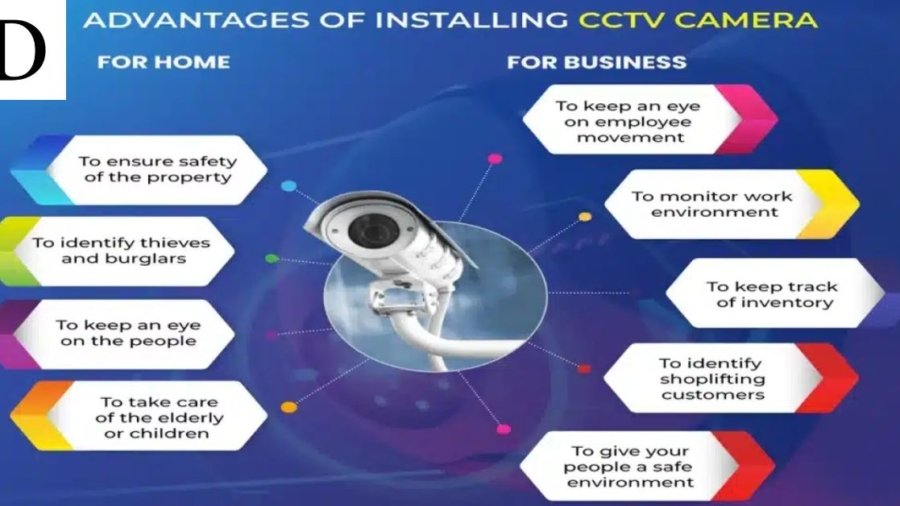In today’s security-conscious world, CCTV cameras have become ubiquitous. From bustling city centers to quiet suburban neighborhoods, their watchful lenses promise a sense of safety and deterrence. But beyond the perceived omnipresence, CCTV cameras offer a multitude of benefits that contribute to a comprehensive security strategy. This guide delves into the benefits of CCTV cameras, exploring their impact on crime prevention, investigation assistance, and overall security enhancement.
Benefits of CCTV Cameras
There are various benefits of CCTV cameras but a few of these are discussed below:
Crime Deterrence: The Psychological Power of Surveillance
One of the most significant benefits of CCTV cameras is their ability to deter criminal activity. The very presence of these cameras serves as a constant reminder to potential offenders that their actions are being monitored. This psychological deterrent can significantly reduce the likelihood of crimes such as:
- Theft: Knowing their actions are being recorded discourages individuals from attempting theft of property or valuables.
- Vandalism: The potential for identification and prosecution discourages acts of vandalism on buildings or public spaces.
- Trespassing: Cameras act as a virtual barrier, deterring unauthorized access to restricted areas.
- Disorderly Conduct: The awareness of being recorded can encourage individuals to behave more responsibly in public areas.
The effectiveness of deterrence depends on several factors, including:
- Visibility: Cameras strategically placed in well-lit areas are more likely to be noticed and act as a deterrent.
- Signage: Clear signage informing individuals that they are being monitored reinforces the deterrent effect.
- Camera Quality: High-resolution cameras with good night vision capabilities create a sense of certainty that crimes will be captured, discouraging potential offenders.
Beyond Deterrence: Enhancing Investigations and Evidence Collection
While deterrence is a valuable aspect of CCTV cameras, their benefits extend far beyond simply discouraging crime. These systems play a crucial role in assisting law enforcement during investigations:
- Evidence Collection: Recorded footage provides valuable visual evidence that can help identify suspects, reconstruct events, and strengthen criminal cases.
- Crime Scene Analysis: By reviewing footage, investigators can gain valuable insights into the sequence of events, the number of perpetrators involved, and their movements at the crime scene.
- Witness Identification: Video recordings can corroborate witness testimonies or even identify suspects who might not have been noticed by witnesses in the heat of the moment.
- Post-Incident Reconstruction: Footage can be used to reconstruct the timeline of an event, helping investigators understand what transpired before, during, and after the incident.
The benefits of CCTV cameras in aiding investigations depend on factors including:
- Camera Coverage: Having cameras positioned to capture the crime scene and potential escape routes is crucial for providing comprehensive footage.
- Data Storage: Implementing a robust data storage system ensures recorded footage is preserved for a sufficient period and readily available for investigators.
- Data Security: Implementing robust data security measures protects recordings from unauthorized access and tampering, ensuring their integrity as evidence.
More Than Crime: Addressing Safety Concerns Beyond Criminal Activity
CCTV cameras offer a wider range of benefits that extend beyond traditional crime prevention and investigation. Here are some additional advantages these systems provide:
- Monitoring Public Safety: Cameras can be used to monitor areas prone to accidents, such as traffic intersections or construction zones, allowing for faster intervention in case of emergencies.
- Enhancing Workplace Safety: Cameras can be placed in strategic locations within workplaces to monitor for safety hazards or potential accidents, promoting a safer work environment.
- Traffic Monitoring: Footage from strategically placed cameras can be used to analyze traffic patterns, identify bottlenecks, and optimize traffic flow, improving overall traffic management.
- Monitoring Vulnerable Individuals: In settings with vulnerable individuals, such as nursing homes or childcare facilities, cameras can be used to ensure their safety and well-being.
However, it’s important to note that using CCTV cameras in such scenarios requires careful consideration of privacy concerns. Striking a balance between security and privacy is crucial, and specific protocols should be in place regarding camera placement, data storage, and access.
Beyond the Obvious: Additional Advantages of CCTV Systems
The benefits of CCTV cameras extend even further. Here are some additional advantages to consider:
- Improved Response Times: Real-time monitoring allows security personnel to identify incidents as they unfold, enabling a faster and more effective response.
- Increased Public Perception of Safety: The visible presence of CCTV cameras can foster a sense of security and deter crime in public spaces, contributing to a more secure environment for everyone.
- Insurance Benefits: Having a CCTV system in place might qualify you for lower insurance premiums due to the perceived reduction in risk and the potential for valuable evidence collection.
- Monitoring Remote Locations: CCTV cameras can be used to monitor remote or unattended locations, such as warehouses or storage facilities, reducing the need for constant physical presence.
Navigating the Concerns: Balancing Security with Privacy
While the benefits of CCTV cameras are undeniable, their widespread use raises legitimate concerns about individual privacy. The constant feeling of being watched can be unsettling, potentially leading to a chilling effect on behavior and a stifling of free movement, particularly in public spaces.
Here are some key considerations regarding privacy concerns:
- Data Misuse and Lack of Transparency: Recorded footage raises concerns about potential misuse. Without robust data security protocols and clear oversight mechanisms, there’s a risk of unauthorized access to footage, leading to privacy violations.
- Facial Recognition Technology: The increasing sophistication of facial recognition software raises serious privacy concerns. This technology allows for the identification of individuals in public spaces, even without their consent. This raises the specter of mass surveillance and potential misuse for discriminatory practices.
- Lack of Clear Regulations and Public Notification: Current regulations around CCTV camera usage often lack clarity and enforcement. Ambiguity regarding camera placement, data storage practices, and public notification about surveillance creates a lack of transparency and fosters distrust.
Striking a Balance: Solutions for Responsible CCTV Camera Use
Fortunately, there are steps to mitigate privacy risks and ensure a more responsible use of CCTV cameras. Here are some potential solutions to consider:
- Regulation and Oversight: Stronger regulations are essential. These regulations should limit the placement of CCTV cameras in public spaces, mandate clear signage informing individuals about surveillance, and ensure robust data security measures are implemented.
- Data Security Measures: Protecting recorded footage from unauthorized access is crucial. Encryption, limited access protocols, and clear data retention policies are essential to ensure responsible data management.
- Transparency and Public Awareness: Transparency builds trust. The public deserves clear information about camera usage, data retention periods, and their rights regarding recorded footage.
- Individual Rights: Individuals should have the right to know if they are being filmed and have mechanisms to request footage deletion when it’s no longer necessary for security purposes.
- Impact Assessments and Community Involvement: Before deploying CCTV systems, conducting thorough assessments is vital. This should include evaluating potential privacy risks and involving the community in the decision-making process.
A Future with Secure and Responsible Surveillance
CCTV cameras have become an undeniably significant part of our modern security landscape. Their presence doesn’t necessitate sacrificing individual privacy. By acknowledging the valid concerns, advocating for robust data security protocols, and demanding clear regulations, we can work towards a future where security and privacy co-exist harmoniously. It’s a future where CCTV cameras fulfill their primary function – deterring crime and ensuring safety – without eroding our fundamental right to privacy.
A Collaborative Approach for a Secure and Private Future
The conversation surrounding CCTV cameras necessitates a collaborative approach. Finding the right balance between security and privacy requires ongoing dialogue between citizens, lawmakers, technology developers, and privacy advocates.
By promoting transparency, advocating for strong regulations, and fostering innovation in privacy-enhancing technologies, we can create a future where security flourishes alongside the fundamental right to privacy. Ultimately, the goal is to leverage technology for the greater good, ensuring public safety without sacrificing the core values of a free and democratic society.
Buy CCTV Cameras in UAE. Go to Home.

